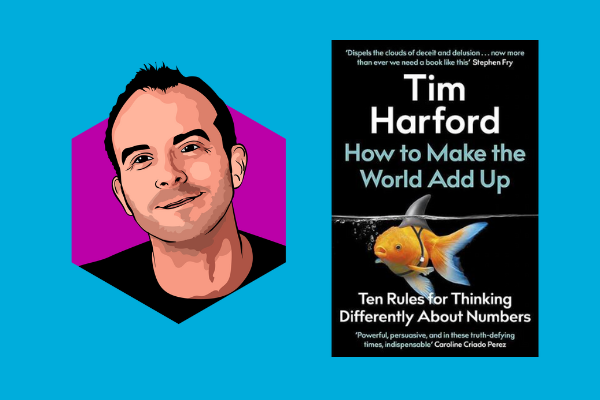"I’ve come to realise that this clear thinking is only rarely a matter of technical expertise," says Tim Harford, author of How to Make the World Add Up.
"Instead, it requires an effort to overcome our biases, set aside our preconceptions, and see beyond our emotional reactions."

Tim posits the importance of curiosity and critical thinking when approaching every statistic. But this requires a delicate balance. We need to be sceptical but not cynical, and receptive without being fooled.
Tim offers an approach to this, summed up in two golden words: Be Curious.
Presentation and interpretation of data, especially in our world where it appears in landslides, can be tricky. Even dangerous, when wielded improperly. In Tanzania criticising official data is even a criminal offence. So, data is vital to our daily lives, from art to business to the news media, but it can easily be misinterpreted and spread around when taken at face value.
Stats and figures should be used to aid public debate, not shut it down, suggests the book. This has led to Tim's 10 rules for sensible data usage. Basically, the message is to stop before you draw any conclusions and make sure you understand the context.
It's important to ask a few questions before interpreting a piece of data. What does the data tell you? How can it be contextualised? What doesn't it tell you, and what might be missing? Then you have to ask: what personal biases might I be bringing to my interpretation?
Let's see what the data detective has to say. I promise that's not a 70s detective show.
When was the last time you read a grand statement, accompanied by a large number, and wondered whether it could really be true? Statistics are vital in helping us tell stories – we see them in the papers, on social media, and we hear them used in everyday conversation – and yet we doubt them more than ever.
- Tim Harford
We're bringing you the best insights written in the world of marketing today, thanks to our sponsors at Treasure Data! Stay tuned for more! 📖📚
Why How to Make the World Add Up is Vital for Any Modern Marketer
Well, How to Make the World Add Up is pretty darn timely. It follows more than a decade of statistical mishaps and data difficulties which has shaken society up. That's not hyperbole.
From social media to big data to alternative facts, to algorithms-gone-wild, and AI informed by bad data, it's no surprise that people have been tricked and convinced by dubious information.
Tim, then, suggests that people develop a framework for seeing through headlines and promoted data, to make sure they really understand what is going on, and to see if there is any difference between what is being reported, and what is actually happening. So, we should:
- Be aware of our own biases and heightened emotions, and how they could reflect on our interpretation of an event.
- Combine a birds-eye view of the data, with a more pin-pointed, detailed one.
- Understand how the number reported was calculated
- See where the data is coming from
- Find comparisons and contextual factors, to put the data into perspective
- Look for selection bias - this means making sure you're filling in the gaps
- Scrutinise the algorithms behind the data
- Trust official statistics and statisticians
- Avoid being tricked by nice-looking charts, and instead see what the data is actually showing
- Keep an open mind. Be willing to change your opinion based on the information, rather than the information to your opinion.
But what sums up these 10 points is the continued encouragement of curiosity. Tim believes curiosity is the antidote to a politically polarised world, where numbers and statistics are used for personal and political gain.
Babies are delivered by storks. Believe me. It can be proven by statistics. The number of babies born every year in Europe, and the stork population, show a very strong similarity between the two figures. Viola, causation proven. Well, not quite. If someone wanted to prove one caused the other, this 'fact' could be used to help them.
This is why it's important not to take facts at face value. Instead, learning how to read statistics is a skill to be developed, not something you can just do innately. Statistics can be infinitely useful, especially in life-threatening circumstances, such as a certain global pandemic. This is why they need to be repurposed, not thrown out completely.
So, marketers need to be aware of how these biases can reflect on their own work, on what strategies they use, and how they decide on their marketing spend. A very nice stat might point you towards the next shiny-new-thing, but be aware of how the data is being presented by a journalist or vendor, and your own personal biases.
About the Author
Tim Harford's experience in the space comes from his roles as an economist and presenter of the BBC radio show More or Less. He is also a senior columnist for the Financial Times and has even been awarded the OBE 'For Services to Improving Economic Understanding' in 2019.
On top of this, he was the winner of the Bastiat Prize for economic journalism in 2006, and his radio show was commended for excellence in journalism by the Royal Statistical Society in 2010, 2011, and 2012.
His other books include The Fifty Things that Made the Modern Economy, The Next Fifty Things that Made the Modern Economy, Messy, The Undercover Economist, and The Logic of Life and Adapt.
Top Takeaways
What are the top takeaways and points made by How to Make the World Add Up: Ten Rules for Thinking Differently About Numbers?
- People with differing political views, who have the ability to be scientifically curious, are more likely to engage civilly. So, if individuals aim to find out the truth, rather than seek to have their prejudices reinforced, they have more of an opportunity to agree with those with conflicting ideas on basic standards of evidence for claims. This means you begin to argue with the same language and context, leading to a more effective discussion. Lovely.
- Don't take statistical bedrock for granted. Tim suggests that one of the main issues with statistics is that they can be used to prove anything.
- Avoid the ostrich effect. People might be tempted to avoid any statistic that doesn't fit their biases, but you shouldn't put your head in the sand as soon as a difficult piece of information comes along.
- Misinformation can be beautiful. Tim warns against shiny, selectively chosen stats. An example of this is when a company or government presentation is shown in a specific manner and worded carefully to show facts, without disclosing the truth. By using certain scales and pictures, and particular achievements, a very crafted message can be conveyed. Even algorithms and AIs can be misleading in this way.
- Keep an open mind. Personally, we should keep an open mind and not be so dogmatic in our views on data movements. He gives the example of economist Irving Fisher. Fisher made his money by predicting future events but refused to change his view as the Depression set in. This led to him losing his entire wealth pretty darn quickly.
Team reviews
Reviewed by: Graham Charlton, Head of Content at LXA

-
Statistics can deceive, but they can also enlighten and inform us. Harford’s book can help us see the true picture behind the data, by following his 10 simple rules.These rules help us to understand and look beyond our emotional biases, to look at data in the correct context, to understand how data is collected, and to keep an open mind - allow data to change our preconceptions, rather than making it fit around them.This book can help us to understand the data behind the headlines but also, in a world where the effectiveness of marketing depends on the ability to understand and interpret different sources of data, it contains some highly valuable lessons for marketers.
- We can summarise huge quantities of data
- We can generate insights that might not otherwise be apparent
- We can recognise patterns that can refine how we do things
- We can evaluate campaign effectiveness
- We can make better decisions
They also need to know the differences between descriptive and predictive data. They need to know the limitations of descriptive data. This includes knowing when they should be asking about the median rather than the mean.
Final Thoughts
If we want to make the world add up, we need to ask questions – open-minded, genuine questions. And once we start asking them, we may find it is delightfully difficult to stop.
- Tim Harford
This book provides a combination of entertaining and unexpected stories which help the reader to put the ideas into context. As a result, these fables mean they can develop the skills to interpret the world of statistics, facts, and figures.
But Tim's book goes further than just teaching its reader how to understand stats and information. It also encourages them to see what isn't there. It's all about how to see what we don't realise is missing.
Due to the sheer amount of information funnelled towards us on a daily basis, it's easy to become complacent. So, we need to become more adept at avoiding reading information at face value, learn to question assumptions about that information, see what was not considered, and what might have tilted the information one way or another.
Numbers, in the right context, have the ability to provide life-changing and society-changing information. They help us see our world more clearly. So, it becomes a vital modern skill that can be developed with just a small amount of curiosity, discernment, and a willingness to see beyond the surface. Wait, I think I just got the front cover.
Link to purchase page
Purchase Tim Harford's How to Make the World Add Up on Amazon, Audible, or through his site.
Other Books You May Be Interested In
- Obviously Awesome - April Dunford
- Happy Sexy Millionaire - Steven Bartlett
- Thinking, Fast and Slow - Daniel Kahneman
- The Choice Factory - Richard Shotton
- Superfans - Pat Flynn
We're bringing you the best insights written in the world of marketing today, thanks to our sponsors at Treasure Data! Stay tuned for more! 📖📚

